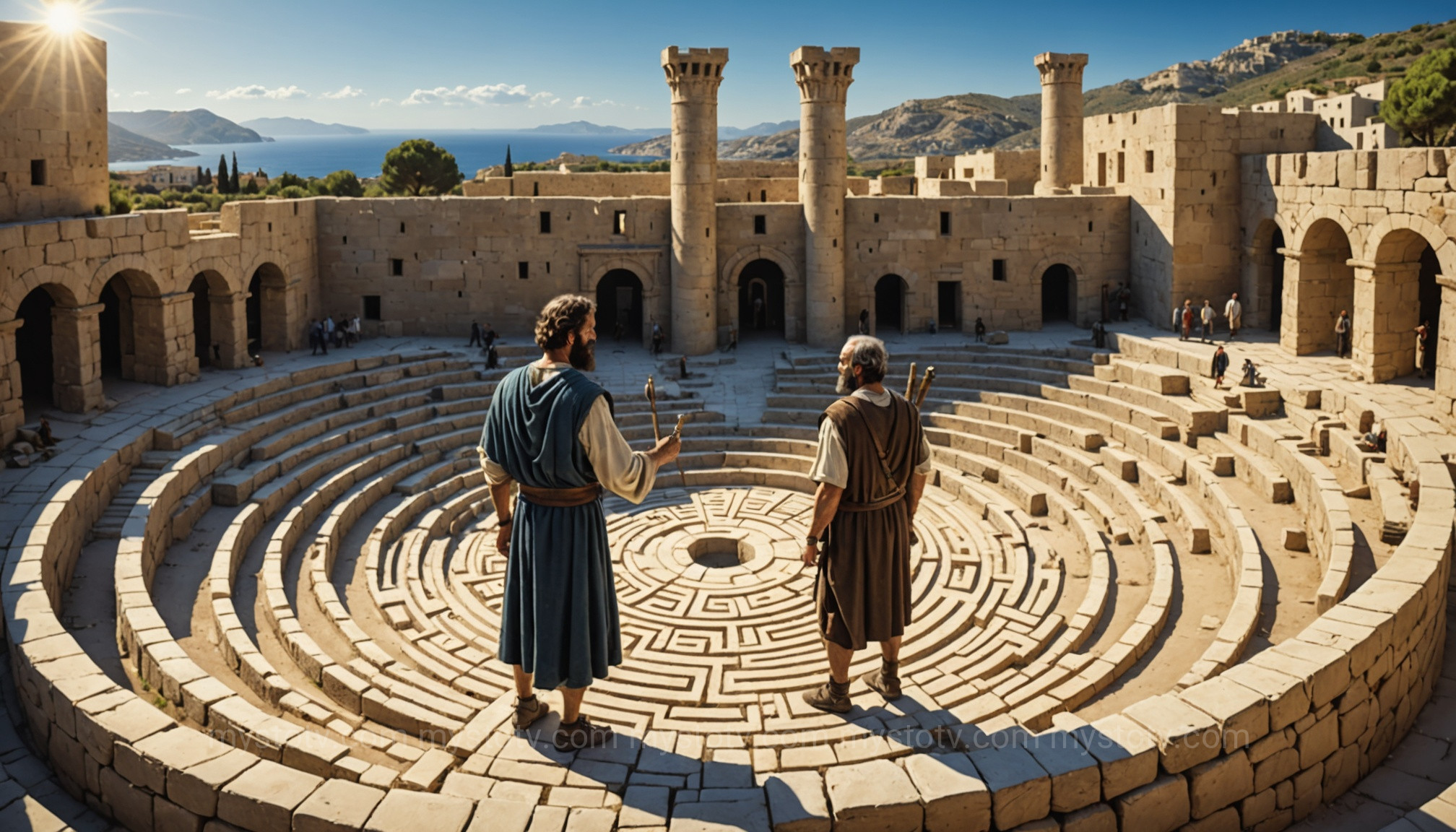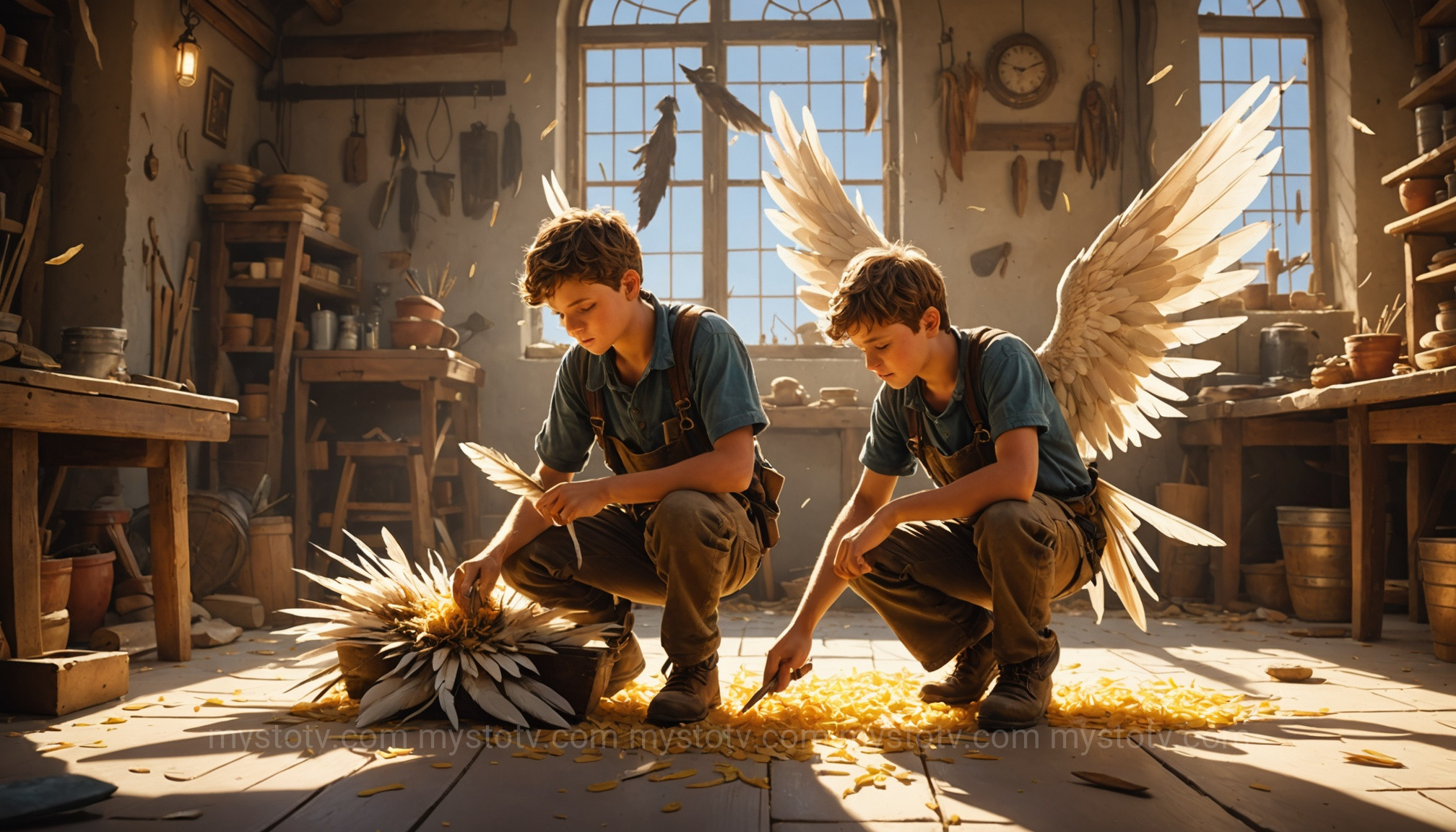Contents
- 1 The Genius in Chains: Understanding the story of Icarus and Daedalus's Captivity
- 2 The Ingenious Escape: The Wings in the story of Icarus and Daedalus
- 3 The Tragic Flight: Ambition and Warning in the story of Icarus and Daedalus
- 4 The Aftermath and Legacy: The Enduring Moral of the story of Icarus and Daedalus
- 5 Frequently Asked Questions about the Story of Icarus and Daedalus
- 6 Conclusion: The Timeless Warning of Ambition
- 7 References
The Genius in Chains: Understanding the story of Icarus and Daedalus's Captivity

The tale begins not with flight, but with entrapment. Daedalus was a master inventor and craftsman from Athens, revered throughout Greece as a genius. His skill was so legendary that he was said to be able to create automatons that moved on their own. However, consumed by jealousy, he murdered his talented nephew and apprentice, Talos, and was exiled from Athens. He found refuge in Crete, serving the powerful King Minos.
Daedalus, the Master Craftsman of Crete
In the court of King Minos, Daedalus's talents flourished. He created wondrous marvels for the royal family. His most fateful creation, however, came at the request of Minos's wife, Queen Pasiphaë. He constructed a hollow wooden cow so she could satisfy her unnatural desire for a divine white bull sent by Poseidon. The result of this union was the monstrous Minotaur—a creature with the body of a man and the head of a bull. This event sets the tragic stage for the rest of the story of Icarus and Daedalus, as Daedalus's own genius becomes the instrument of his downfall.
The Labyrinth and the Minotaur's Secret
To contain the horrifying beast and hide his family's shame, King Minos commanded Daedalus to build an inescapable prison: the Labyrinth. This was a complex and bewildering maze, so cleverly designed that once inside, no one could find their way out. Daedalus, the creator, was the only one who knew its secrets. After its completion, the Minotaur was locked within, and Daedalus's role in the monster's conception was a secret he and the king shared. This knowledge, however, made him a liability.
The Wrath of King Minos
Daedalus's fate was sealed when he helped the Athenian hero Theseus. Ariadne, King Minos's daughter, had fallen in love with Theseus, who had arrived as a tribute to be fed to the Minotaur. She begged Daedalus for help, and he, perhaps out of pity or a desire to subvert the cruel king, gave her a ball of thread. He instructed her to have Theseus tie one end at the Labyrinth's entrance and unravel it as he went, allowing him to slay the Minotaur and find his way back out. When King Minos discovered Daedalus's betrayal, his fury was absolute. He couldn't kill the inventor whose skills he might still need, so he imprisoned Daedalus and his young son, Icarus, within the very Labyrinth the craftsman had built. The genius was trapped by his own creation.
The Ingenious Escape: The Wings in the story of Icarus and Daedalus

Trapped on the island of Crete, with the land and sea routes controlled by King Minos's powerful navy, Daedalus's mind turned to the only path left: the sky. He observed the flight of seabirds, studying the mechanics of their wings and forming a daring plan. This section of the story of Icarus and Daedalus highlights the myth's core theme of human ingenuity and the burning desire for freedom.
A Desperate Plan for Freedom
“Minos may control the land and sea,” Daedalus reportedly said, “but he does not control the air.” This famous declaration captures the essence of his ambition. He was not just an inventor but an innovator willing to challenge the natural order to reclaim his liberty. He gathered feathers of all sizes, from the smallest to the largest, that had fallen from birds near their prison tower. He began to arrange them, creating a tool to defy both a king and the gods.
Crafting Feathers and Wax
The construction of the wings was a masterpiece of primitive engineering. Daedalus arranged the feathers in rows, starting with the smallest and gradually adding longer ones to mimic the curve of a bird's wing. He bound the middle of the feathers together with thread and secured the bases with beeswax. His son, Icarus, played nearby, chasing feathers and molding the wax, unaware of the immense danger their new toys represented. He was simply a child, fascinated by his father's incredible work. Once Daedalus had fashioned two pairs of these magnificent wings, the path to freedom was ready. The invention was brilliant, but its success depended entirely on the user's discipline—a frail foundation for a plan involving an impetuous youth.
The Tragic Flight: Ambition and Warning in the story of Icarus and Daedalus
With the wings complete, the moment of truth arrived. Before they took flight, Daedalus gave his son a lesson that was part technical instruction and part desperate plea. This critical exchange in the story of Icarus and Daedalus contains the central moral that has echoed through millennia: the importance of moderation, or the "golden mean."
The Father's Warning: A Middle Path
As he fitted the wings to Icarus's small shoulders, tears streamed down Daedalus's face. He was terrified for his son, understanding the fragility of his own invention. He gave Icarus a strict warning: "My son, I caution you to keep the middle way. If you fly too low, the damp from the sea will clog your wings. If you fly too high, the heat from the sun will melt the wax. Follow my path, stay close to me." It was a lesson not just in aerodynamics but in life—a plea to avoid the extremes of recklessness and timidity.
Icarus's Exhilaration and Hubris

At first, Icarus heeded his father's words. The sensation of flight was exhilarating. Fishermen and shepherds on the ground looked up in astonishment, mistaking them for gods. This taste of divine power was too much for the boy. Overcome with the joy and freedom of flight, a dangerous pride—what the Greeks called hubris—filled his heart. He forgot his father's warning and began to soar upward, driven by a reckless ambition to reach the heavens.
The Inevitable Fall
As Icarus climbed higher, he drew closer to the sun god, Helios, driving his fiery chariot across the sky. The sun's intense heat softened the fragrant beeswax that held the feathers in place. The wings began to fail. Icarus flapped his arms, but with the feathers gone, he was only beating the empty air. He cried out for his father, but it was too late. He plunged from the sky and into the sea below. Daedalus, hearing his son's cries, looked around frantically. All he could see were stray feathers floating on the waves. The very invention that promised freedom had delivered death.
The Aftermath and Legacy: The Enduring Moral of the story of Icarus and Daedalus
The tragic climax gives way to a somber conclusion. Daedalus's story does not end with Icarus's fall; it is forever marked by it. The final act explores the themes of grief, regret, and the lasting meaning drawn from the complete story of Icarus and Daedalus.
Daedalus's Grief and a New Life
Heartbroken, Daedalus circled the area until he found his son's body washed ashore on an island. He named the island Icaria in his son's memory. The nearby sea where he fell is still called the Icarian Sea. He then flew to Sicily, where he finally found safety. But his triumph was hollow. In a temple dedicated to Apollo, he hung up his magnificent wings as an offering, never to fly again. The great inventor cursed his own art, which had cost him his only son. His ambition to escape had been realized, but the price was unbearable.
Interpreting the Myth's Lessons
The story of Icarus and Daedalus is a cautionary tale about ambition. It is not a condemnation of ambition itself—after all, Daedalus's ambition led to one of humanity's most dreamed-of achievements. Instead, it is a warning against unbalanced ambition. Icarus represents youthful hubris and the failure to respect limits, both natural and advised. Daedalus embodies the tragedy of creation without control; his genius gave his son the means to fly, but he could not impart the wisdom to do so safely.
The myth compels us to seek the "middle way" that Daedalus advised—a balance between striving for greatness and understanding our own limitations. It teaches that technology and innovation, for all their power, are only as good as the wisdom of those who wield them. These timeless lessons are why the myth continues to resonate so deeply in our modern world of rapid technological advancement.
Frequently Asked Questions about the Story of Icarus and Daedalus
What is the main moral of the story of Icarus and Daedalus?
The primary moral is the importance of moderation and the dangers of hubris (excessive pride or ambition). Daedalus's instruction to fly a "middle way"—not too high and not too low—is the central lesson. Icarus's tragedy serves as a powerful cautionary tale against ignoring wise counsel and overestimating one's own abilities, especially when dealing with new and powerful technology.
Who was to blame for Icarus's death, Daedalus or Icarus himself?
This is a classic question of interpretation with no single answer. One could argue Icarus is to blame for his disobedience and hubris; he was explicitly warned of the dangers and chose to ignore them. Conversely, one could argue Daedalus bears responsibility for creating such a dangerous device and giving it to an inexperienced youth, placing an impossible burden of discipline on his son. The myth's power lies in this ambiguity, showing that tragedy often arises from a combination of flawed genius and youthful recklessness.
What happened to Daedalus after Icarus fell?
After burying his son on the island he named Icaria, Daedalus continued his flight to Cumae in Sicily. There, he built a temple to the god Apollo and hung up his wings, renouncing his craft and the sky forever. While he escaped King Minos and lived out his days, he was forever a broken man, haunted by the memory of his son and the tragic consequences of his own brilliant invention.
Conclusion: The Timeless Warning of Ambition
The complete story of Icarus and Daedalus remains one of the most poignant and powerful myths ever told. From the genius and desperation that led to the creation of the wings to the tragic flight that ended in a watery grave, the narrative serves as a profound allegory for the human condition. It explores the dual nature of ambition: the creative force that drives us to innovate and reach for the sky, and the destructive arrogance that can cause us to fly too close to the sun. Like my early coding misadventures, the tale is a humbling reminder that great power requires even greater wisdom and that the most brilliant creations are worthless without the moderation to control them.
References
- Ovid. Metamorphoses. Book VIII, lines 183-235. (~8 A.D.).
- Cartwright, Mark. "Daedalus." World History Encyclopedia. Published 19 May 2012. https://www.worldhistory.org/Daedalus/
- Atsma, Aaron J. "Daedalus & Icarus." Theoi Greek Mythology. 2000-2017. https://www.theoi.com/Text/OvidMetamorphoses8.html#5